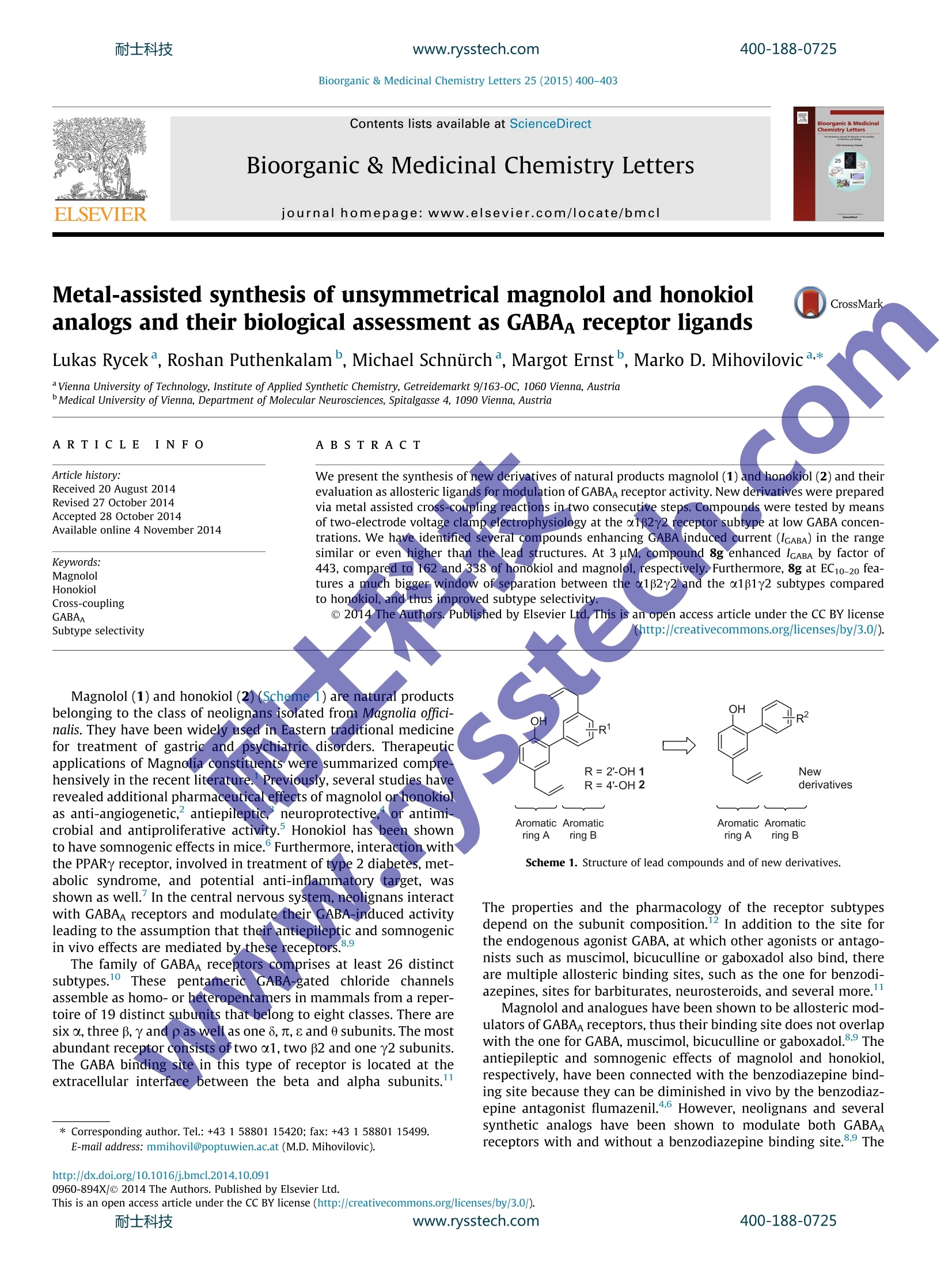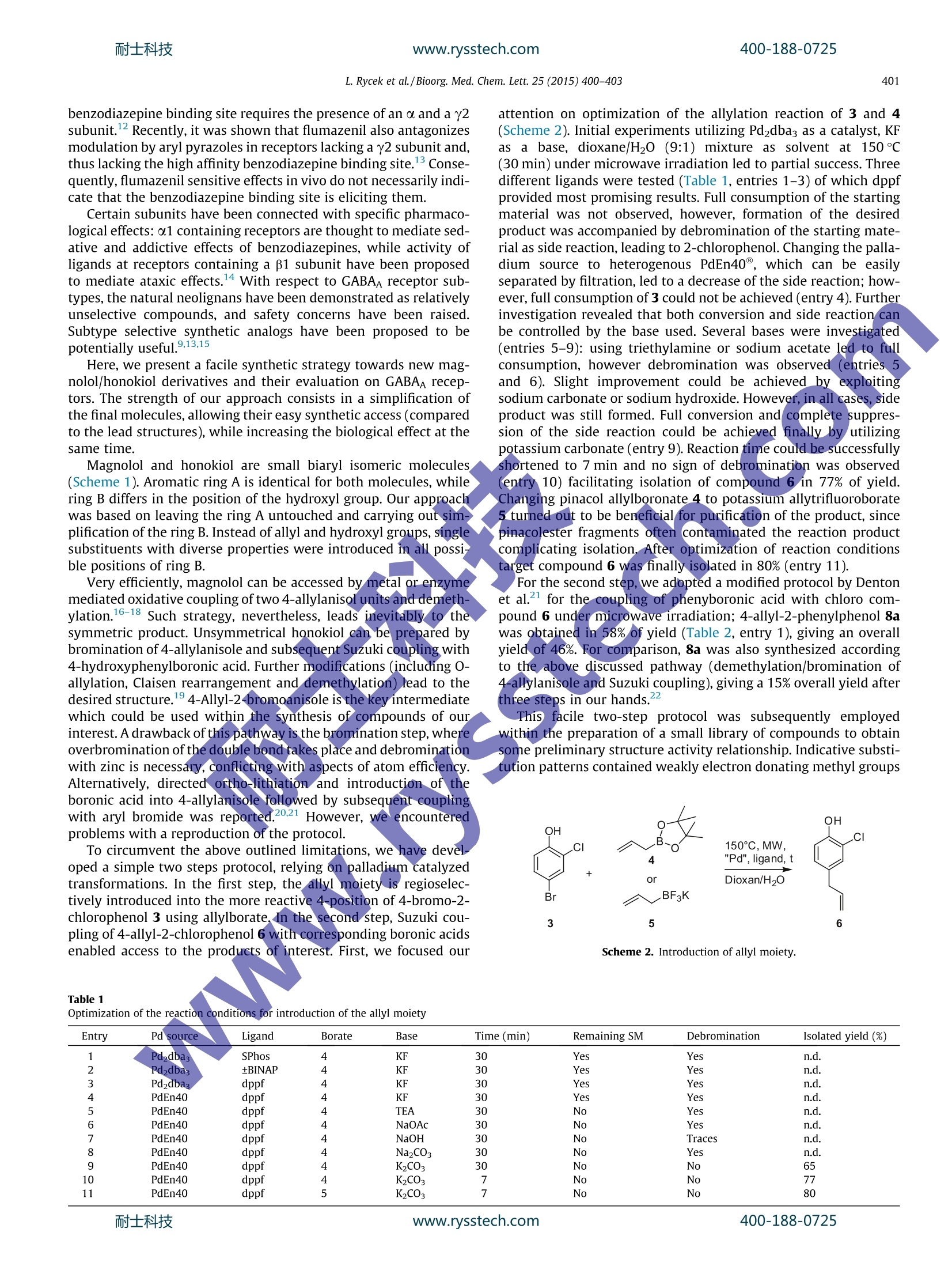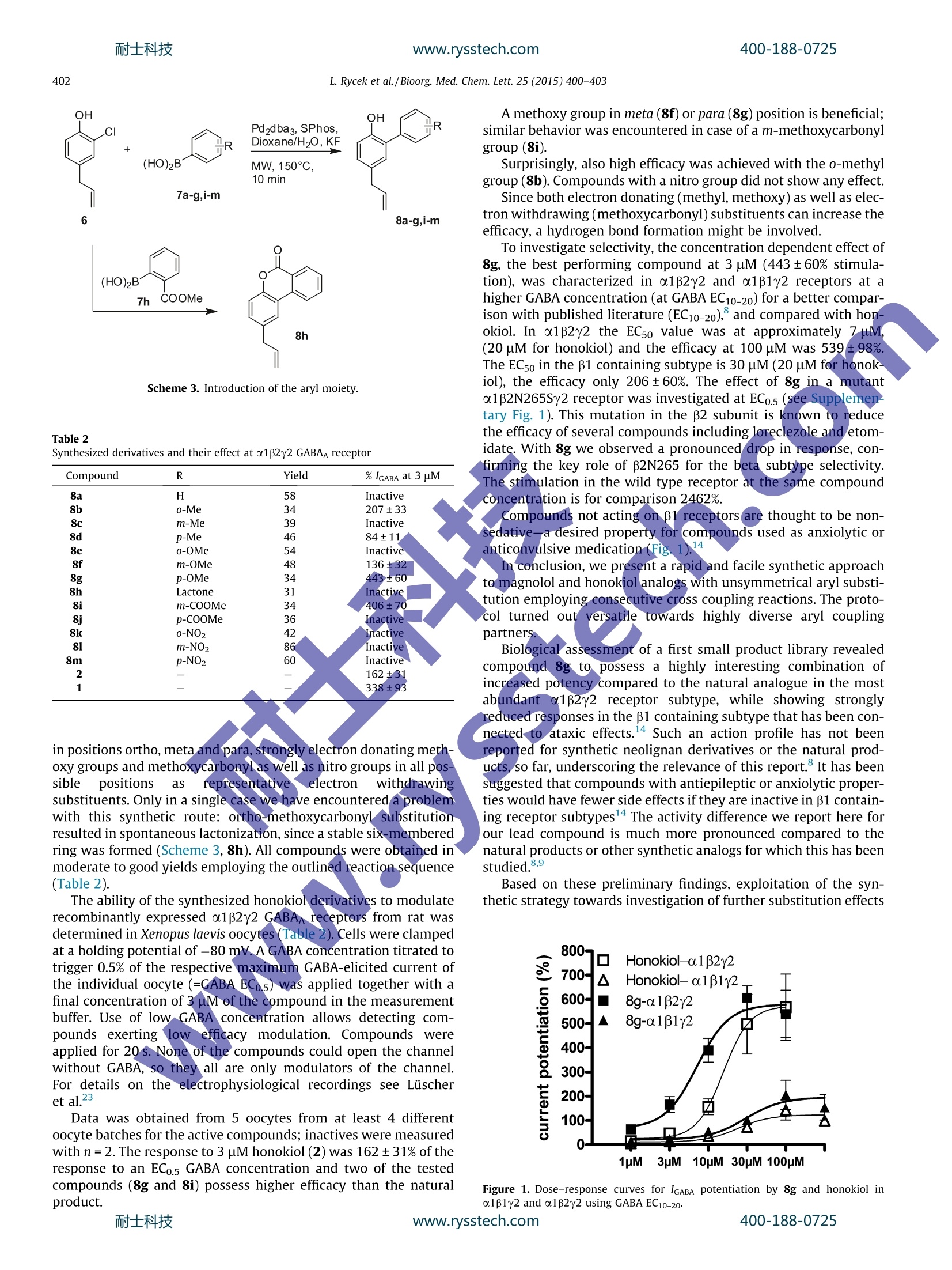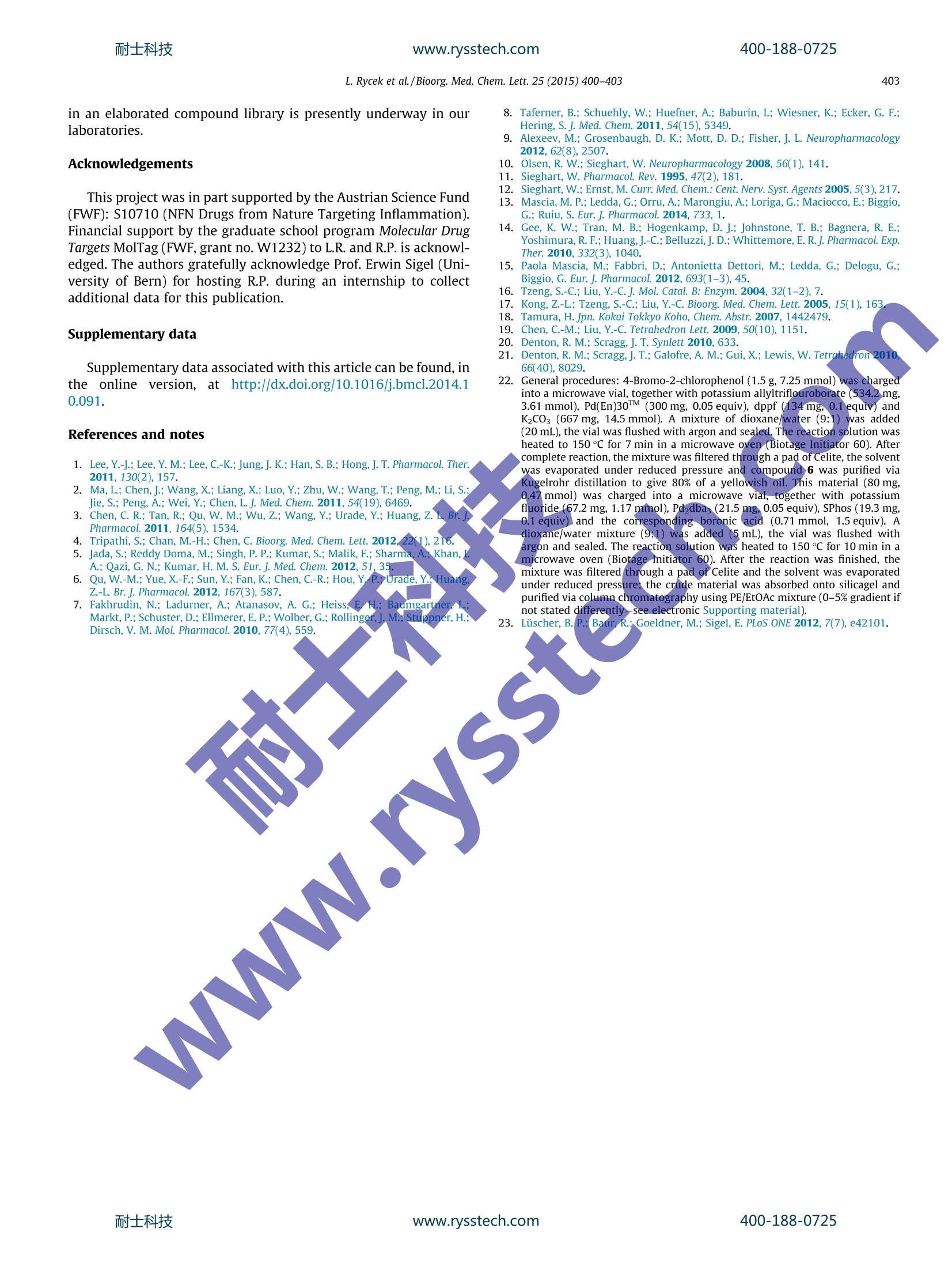
We present the synthesis of new derivatives of natural products magnolol (1) and honokiol (2) and their evaluation as allosteric ligands for modulation of GABAA receptor activity. New derivatives were prepared via metal assisted cross-coupling reactions in two consecutive steps. Compounds were tested by means of two-electrode voltage clamp electrophysiology at the a1b2c2 receptor subtype at low GABA concentrations. We have identified several compounds enhancing GABA induced current (IGABA) in the range similar or even higher than the lead structures. At 3 lM, compound 8g enhanced IGABA by factor of 443, compared to 162 and 338 of honokiol and magnolol, respectively. Furthermore, 8g at EC10–20 features a much bigger window of separation between the a1b2c2 and the a1b1c2 subtypes compared to honokiol, and thus improved subtype selectivity。
方案详情

www.rysstech.comBioorganic & Medicinal Chemistry Letters 25 (2015)400-403耐士科技400-188-0725 耐士科技400-188-0725www.rysstech.com401L. Rycek et al./Bioorg. Med. Chem. Lett. 25 (2015) 400-403 Contents lists available at ScienceDirect Bioorganic & Medicinal Chemistry Lettersjournal homepage: www.elsevier.com/locate/bmcl Metal-assisted synthesis of unsymmetrical magnolol and honokiolanalogs and their biological assessment as GABAA receptor ligands CrossMark Lukas Rycek,Roshan Puthenkalam", Michael Schniirch, Margot Ernst", Marko D. Mihovilovic * Vienna University of Technology, Institute of Applied Synthetic Chemistry, Getreidemarkt 9/163-0C, 1060 Vienna, AustriaMedical University of Vienna, Department of Molecular Neurosciences, Spitalgasse 4, 1090 Vienna,Austria ARTICLEIN F O ABSTRACT Article history:Received 20 August 2014Revised 27 October 2014Accepted 28 October 2014Available online 4 November 2014 Keywords:MagnololHonokiolCross-couplingGABAASubtype selectivity We present the synthesis of new derivatives of natural products magnolol (1) and honokiol (2) and theirevaluation as allosteric ligands for modulation of GABAA receptor activity. New derivatives were preparedvia metal assisted cross-coupling reactions in two consecutive steps. Compounds were tested by meansof two-electrode voltage clamp electrophysiology at the a132y2 receptor subtype at low GABA concen-trations. We have identified several compounds enhancing GABA induced current (IGABA) in the rangesimilar or even higher than the lead structures. At 3 uM, compound 8g enhanced IGABA by factor of443, compared to 162 and 338 of honokiol and magnolol, respectively. Furthermore, 8g at EC10-20 fea-tures a much bigger window of separation between the a12y2 and the o11y2 subtypes comparedto honokiol, and thus improved subtype selectivity. Magnolol(1) and honokiol (2) (Scheme 1) are natural productsbelonging to the class of neolignans isolated from Magnolia offici-nalis. They have been widely used in Eastern traditional medicinefor treatment of gastric and psychiatric disorders. Therapeuticapplications of Magnolia constituents were summarized compre-hensively in the recent literature. Previously, several studies haverevealed additional pharmaceutical effects of magnolol or honokiolas anti-angiogenetic,antiepileptic,neuroprotective,or antimicrobial and antiproliferative activity. Honokiol has been shownto have somnogenic effects in mice.Furthermore, interaction withthe PPARy receptor, involved in treatment of type 2 diabetes, met-abolic syndrome, and potential anti-inflammatory target, wasshown as well. In the central nervous system, neolignans interactwith GABAA receptors and modulate their GABA-induced activityleading to the assumption that their antiepileptic and somnogenicin vivo effects are mediated by these receptors.8.9 The family of GABA receptors comprises at least 26 distinctsubtypes.1These pentameric GABA-gated chloride channelsassemble as homo-or heteropentamers in mammals from a reper-toire of 19 distinct subunits that belong to eight classes. There aresix a, three p,y and p as well as one 8,n, e and e subunits. The mostabundant receptor consists of two o1, two β2 and one y2 subunits.The GABA binding site in this type of receptor is located at theextracellular interface between the beta and alpha subunits. ( * C orresponding author. T el.: + 43 1 5 8801 15420; fax: + 431 5 8 801 15499. ) Scheme 1. Structure of lead compounds and of new derivatives. The properties and the pharmacology of the receptor subtypesdepend on the subunit composition.In addition to the site forthe endogenous agonist GABA, at which other agonists or antago-nists such as muscimol, bicuculline or gaboxadol also bind, thereare multiple allosteric binding sites, such as the one for benzodi-azepines, sites for barbiturates, neurosteroids, and several more. Magnolol and analogues have been shown to be allosteric mod-ulators of GABAA receptors, thus their binding site does not overlapwith the one for GABA, muscimol, bicuculline or gaboxadol.8.9 Theantiepileptic and somnogenic effects of magnolol and honokiol,respectively, have been connected with the benzodiazepine bind-ing site because they can be diminished in vivo by the benzodiaz-epine antagonist flumazenil.4.6 However, neolignans and severalsynthetic analogs have been shown to modulate both GABAreceptors with and without a benzodiazepine binding site.8.9 The ( This i s an open access article under the CC B Y license (ht tp: / /c r e ativecomm o ns . or g /lice n ses/by/3.0/). ) benzodiazepine binding site requires the presence of an o and a y2subunit.Recently, it was shown that flumazenil also antagonizesmodulation by aryl pyrazoles in receptors lacking a y2 subunit and,thus lacking the high affinity benzodiazepine binding site.Conse-quently, flumazenil sensitive effects in vivo do not necessarily indi-cate that the benzodiazepine binding site is eliciting them. Certain subunits have been connected with specific pharmaco-logical effects: o1 containing receptors are thought to mediate sed-ative and addictive effects of benzodiazepines, while activity ofligands at receptors containing a β1 subunit have been proposedto mediate ataxic effects.14 With respect to GABA receptor sub-types, the natural neolignans have been demonstrated as relativelyunselective compounds, and safety concerns have been raised.Subtype selective synthetic analogs have been proposed to bepotentially useful.9,13,15 Here, we present a facile synthetic strategy towards new mag-nolol/honokiol derivatives and their evaluation on GABAA recep-tors. The strength of our approach consists in a simplification ofthe final molecules, allowing their easy synthetic access (comparedto the lead structures), while increasing the biological effect at thesame time. Magnolol and honokiol are small biaryl isomeric molecules(Scheme 1). Aromatic ring A is identical for both molecules, whilering B differs in the position of the hydroxyl group. Our approachwas based on leaving the ring A untouched and carrying out sim-plification of the ring B. Instead of allyl and hydroxyl groups, singlesubstituents with diverse properties were introduced in all possi-ble positions of ring B. Very efficiently, magnolol can be accessed by metal or enzymemediated oxidative coupling of two 4-allylanisol units and demeth-ylation.16-18 Such strategy, nevertheless, leads inevitably to thesymmetric product. Unsymmetrical honokiol can be prepared bybromination of 4-allylanisole and subsequent Suzuki coupling with4-hydroxyphenylboronic acid. Further modifications (including O-allylation, Claisen rearrangement and demethylation) lead to thedesired structure.194-Allyl-2-bromoanisole is the key intermediatewhich could be used within the synthesis of compounds of ourinterest. A drawback of this pathway is the bromination step, whereoverbromination of the double bond takes place and debrominationwith zinc is necessary, conflicting with aspects of atom efficiency.Alternatively, directed ortho-lithiation and introduction of theboronic acid into 4-allylanisole followed by subsequent couplingwith aryl bromide was reported.20.21 However, we encounteredproblems with a reproduction of the protocol. To circumvent the above outlined limitations, we have devel-oped a simple two steps protocol,relying on palladium catalyzedtransformations. In the first step, the allyl moiety is regioselec-tively introduced into the more reactive 4-position of 4-bromo-2-chlorophenol 3 using allylborate. In the second step, Suzuki cou-pling of 4-allyl-2-chlorophenol 6 with corresponding boronic acidsenabled access to the products of interest. First, we focused our attention on optimization of the allylation reaction of 3 and 4(Scheme 2). Initial experiments utilizing Pd2dba3 as a catalyst, KFasaSa base, dioxane/H20(9:1) mixture as solvent at1150°C(30 min) under microwave irradiation led to partial success. Threedifferent ligands were tested (Table 1, entries 1-3) of which dppfprovided most promising results. Full consumption of the startingmaterial was not observed, however, formation of the desiredproduct was accompanied by debromination of the starting mate-rial as side reaction, leading to 2-chlorophenol. Changing the palla-dium source to heterogenous PdEn40@, which can be easilyseparated by filtration, led to a decrease of the side reaction; how-ever, full consumption of 3 could not be achieved (entry 4). Furtherinvestigation revealed that both conversion and side reaction canbe controlled by the base used. Several bases were investigated(entries 5-9): using triethylamine or sodium acetate led to fullconsumption, however debromination was observed((6entries 5and 6). Slight improvement could be achieved byexploitingsodium carbonate or sodium hydroxide. However, in all cases, sideproduct was still formed. Full conversion and complete suppres-sion of the side reaction could be achieved finally by utilizingpotassium carbonate (entry 9). Reaction time could be successfullyshortened to 7 min and no sign of debromination was observed(entry10) facilitating isolation of compound 6 in 77% of yield.Changing pinacol allylboronate 4 to potassium allytrifluoroborate5 turned out to be beneficial for purification of the product, sincepinacolester fragments often contaminated the reaction productcomplicating isolation. After optimization of reaction conditionstarget compound 6 was finally isolated in 80% (entry 11). For the second step, we adopted a modified protocol by Dentonet al. for the coupling of phenyboronic acid with chloro com-pound 6 under microwave irradiation; 4-allyl-2-phenylphenol 8awas obtained in 58% of yield (Table 2, entry 1), giving an overallyield of 46%. For comparison, 8a was also synthesized accordingto the above discussed pathway (demethylation/bromination of4-allylanisole and Suzuki coupling),giving a 15% overall yield afterthree steps in our hands.22 Thisfacile two-step protocol was subsequently employedwithin the preparation of a small library of compounds to obtainsome preliminary structure activity relationship. Indicative substi-tution patterns contained weakly electron donating methyl groups Table 1Optimization of the reaction conditions for introduction of the allyl moiety Entry Pd source Ligand Borate Base Time (min) Remaining SM Debromination Isolated yield (%) 1 Pd dba3 SPhos 4 KF 30 Yes Yes n.d. 2 Pd dba3 ±BINAP 4 KF 30 Yes Yes n.d. 3 Pd2dba3 dppf 4 KF 30 Yes Yes n.d. 4 PdEn40 dppf 4 KF 30 Yes Yes n.d. 5 PdEn40 dppf 4 TEA 30 No Yes n.d. 6 PdEn40 dppf 4 NaOAc 30 No Yes n.d. 7 PdEn40 dppf 4 NaOH 30 No Traces n.d. 8 PdEn40 dppf 4 Na2CO: 30 No Yes n.d. 9 PdEn40 dppf 4 K2CO3 30 No No 65 10 PdEn40 dppf 4 K2CO3 7 No No 77 11 PdEn40 dppf 5 K2CO3 7 No No 80 Scheme 3. Introduction of the aryl moiety. Table 2Synthesized derivatives and their effect at o1β2y2 GABA receptor Compound R Yield %IGABA at 3 pM H Inactive 0-Me 207±33 m-Me Inactive p-Me 84±11 o-OMe Inactive m-OMe 136±32 p-OMe 443±60 Lactone Inactive m-COOMe 406±70 p-CoOMe Inactive 0-NO2 Inactive m-NO, Inactive 8m p-NO2 Inactive 2 162±31 1 338±93 in positions ortho, meta and para, strongly electron donating meth-oxy groups and methoxycarbonyl as well as nitro groups in all pos-sible positions as representative electron withdrawingsubstituents. Only in a single case we have encountered a problemwith this synthetic route: ortho-methoxycarbonyl substitutionresulted in spontaneous lactonization, since a stable six-memberedring was formed (Scheme 3, 8h). All compounds were obtained inmoderate to good yields employing the outlined reaction sequence(Table 2). The ability of the synthesized honokiol derivatives to modulaterecombinantly expressed a1β2y2 GABAA receptors from rat wasdetermined in Xenopus laevis oocytes (Table 2). Cells were clampedat a holding potential of -80 mV. A GABA concentration titrated totrigger 0.5% of the respective maximum GABA-elicited current ofthe individual oocyte (=GABA ECo.5) was applied together with afinal concentration of 3 uM of the compound in the measurementbuffer. Use of low GABA concentration allows detecting com-pounds exerting; lowefficacy modulation. Compounds wereapplied for 20 s. None of the compounds could open the channelwithout GABA, so they all are only modulators of the channel.For details on the electrophysiological recordings see Liischereta1.23 Data was obtained from 5 oocytes from at least 4 differentoocyte batches for the active compounds; inactives were measuredwith n=2. The response to 3 uM honokiol (2) was 162±31% of theresponse to an ECo.5 GABA concentration and two of the testedcompounds (8g and 8i) possess higher efficacy than the naturalproduct. A methoxy group in meta (8f) or para (8g) position is beneficial;similar behavior was encountered in case of a m-methoxycarbonylgroup (8i). Surprisingly, also high efficacy was achieved with the o-methylgroup(8b). Compounds with a nitro group did not show any effect. Since both electron donating (methyl, methoxy) as well as elec-tron withdrawing (methoxycarbonyl) substituents can increase theefficacy, a hydrogen bond formation might be involved. To investigate selectivity, the concentration dependent effect of8g, the best performing compound at 3 uM (443±60% stimula-tion), was characterized in o12y2 and o11y2 receptors at ahigher GABA concentration (at GABA EC10-20) for a better compar-ison with published literature (EC10-20), and compared with hon-okiol. In o12y2 the EC5o value was at approximately 7 pM,(20 uM for honokiol) and the efficacy at 100 uM was 539+98%.The ECso in the β1 containing subtype is 30 pM (20 uM for honokiol), the efficacy only 206±60%. The effect of 8g in a mutanta12N265Sy2 receptor was investigated at ECo.5 (see Supplemen-tary Fig. 1). This mutation in the β2 subunit is known to reducethe efficacy of several compounds including loreclezole and etom-idate. With 8g we observed a pronounced drop in response, con-firming the key role of β2N265 for the beta subtype selectivity.The stimulation in the wild type receptor at the same compoundconcentration is for comparison 2462%. Compounds not acting on p1 receptors are thought to be non-sedative-a desired property for compounds used as anxiolytic oranticonvulsive medication (Fig 1).14 In conclusion, we present a rapid and facile synthetic approachto magnolol and honokiol analogs with unsymmetrical aryl substi-tution employing consecutive cross coupling reactions. The proto-0ccol turned out versatile towards highly diverse aryl couplingpartners. Biological assessment of a first small product library revealedcompound 8g to possess a highly interesting combination ofincreased potency compared to the natural analogue in the mostabundant a12y2 receptor subtype, while showing stronglyreduced responses in the β1 containing subtype that has been con-nected to ataxic effects.14 Such an action profile has not beenreported for synthetic neolignan derivatives or the natural prod-ucts, so far, underscoring the relevance of this report. It has beensuggested that compounds with antiepileptic or anxiolytic proper-ties would have fewer side effects if they are inactive in β1 contain-ing receptor subtypes4 The activity difference we report here forour lead compound is much more pronounced compared to thenatural products or other synthetic analogs for which this has been,89studied.8.9 Based on these preliminary findings, exploitation of the syn-thetic strategy towards investigation of further substitution effects Acknowledgements This project was in part supported by the Austrian Science Fund(FWF): S10710 (NFN Drugs from Nature Targeting Inflammation).Financial support by the graduate school program Molecular DrugTargets MolTag (FWF, grant no. W1232) to L.R. and R.P. is acknowl-edged. The authors gratefully acknowledge Prof. Erwin Sigel (Uni-versity of Bern) for hosting R.P. during an internship to collectadditional data for this publication. Supplementary data Supplementary data associated with this article can be found, inthe online version, athttp://dx.doi.org/10.1016/j.bmcl.2014.10.091. 8.Taferner, B.; Schuehly, W.; Huefner, A.; Baburin,I.; Wiesner, K.; Ecker, G. F.;Hering,S. J. Med. Chem. 2011, 54(15),5349. 9..Alexeev, M.; Grosenbaugh, D. K.; Mott, D. D.; Fisher, J. L. Neuropharmacology2012,62(8),2507. 10.Olsen, R. W.; Sieghart, W. Neuropharmacology 2008,56(1),141. 11.Si:eghart, W. Pharmacol. Rev. 1995,47(2), 181. 12.Si9eghart, W.; Ernst, M. Curr. Med. Chem.: Cent. Nerv. Syst. Agents 2005,5(3), 217. 13.Mascia, M. P.; Ledda, G.; Orru,A.; Marongiu, A.; Loriga, G.; Maciocco,E.; Biggio,G.; Ruiu, S. Eur. J. Pharmacol. 2014, 733, 1. 14. Gee, K.W.; Tran, M. B.; Hogenkamp, D. J; Johnstone, T. B.; Bagnera, R. E.;Yoshimura, R. F.; Huang, J.-C.; Belluzzi, J.D.; Whittemore,E. R. J. Pharmacol. Exp.Ther. 2010,332(3),1040. 15.Paola Mascia, M.; Fabbri, D.; Antonietta Dettori, M.; Ledda, G.; Delogu, G.;Biggio, G. Eur. J. Pharmacol. 2012,693(1-3), 45. 16.Tzeng, S.-C.; Liu, Y.-C. J. Mol. Catal. B: Enzym. 2004,32(1-2), 7. 17.Kong, Z.-L.; Tzeng, S.-C.; Liu, Y.-C. Bioorg. Med. Chem. Lett. 2005, 15(1), 163. 18.Tamura, H. Jpn. Kokai Tokkyo Koho, Chem. Abstr. 2007,1442479. 19.(Chen, C.-M.; Liu, Y.-C. Tetrahedron Lett. 2009,50(10), 1151. 20.Denton,R. M.; Scragg,J. T. Synlett 2010, 633. 21.DeInton,R. M.; Scragg,J. T.; Galofre, A. M.; Gui,X.; Lewis, W. Tetrahedron 2010,66(40),8029. 22. G(eneral procedures: 4-Bromo-2-chlorophenol (1.5 g, 7.25 mmol) was charged into a microwave vial, together with potassium allyltriflouroborate (534.2 mg, http://dx.doi.org/j.bmcl./O The Authors. Published by Elsevier Ltd.ww.rysstech.com耐士科技 www.rysstech.com耐士科技
确定




还剩2页未读,是否继续阅读?
上海鑫欣生物科技有限公司为您提供《化学药中特殊物质和基团检测方案 》,该方案主要用于化药新药研发中其他检测,参考标准--,《化学药中特殊物质和基团检测方案 》用到的仪器有
相关方案
更多
该厂商其他方案
更多








